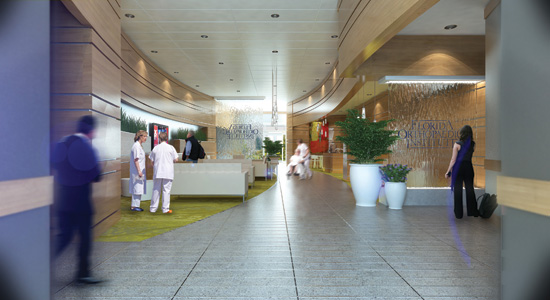Building Information Modeling as a Design Process
CASE STUDY: CREATING WELCOMING SPACES FOR EVERYONE
For designers at ROJO Architecture, working in a space that's suited for play provides just the right mental break to spark their next great idea. Their office sits inside of what was once a busy shopping mall until a recession forced commercial building owners to rethink the space. Principal and Cofounder Rob Glisson enthuses that while the spacious, 25-foot hallways are perfect for throwing footballs, the real benefit of the structure's openness is how it facilitates collaboration. “Anytime you have something to offer to make a project better, you're expected, and able, to do so,” he says.
It's this drive to work cohesively that allows Glisson, Cofounder and Principal John Saldana, and a team of seven other architects to respond to the medical, religious, commercial, hospitality, and private-sector clients they serve. “We're really working for our clients' clients and responding to their needs and desires,” notes Saldana. “We don't necessarily bring a style to the job as much as we let the job bring a style to us, and then we focus on doing that correctly.”
From Retail to Healing: A Space Transformed
One example of ROJO's focus on end users is their conversion of a 27,550-square-foot bookstore into a space conducive to orthopedic care, education, and research for the Florida Orthopaedic Institute. Because the site was once a large, open space with little privacy and no natural light, ROJO was challenged to meet the functional needs of the medical facility, as well as transform the entryway into a welcoming destination.
The result of their efforts is a space that patients and employees are happy to enter because it replicates the vibe of an upscale hotel lobby. The experience begins with a glass wall, featuring a cascading waterfall behind the facility's nameplate. This striking focal point wasn't meant to be an interactive water feature, but people touch this playful design element every day, creating a memorable, if unintended, experience. From there, a winding path cuts through the space, using sophisticated gray and gold carpet that complements wood-lined walls with recessed shelving featuring artwork, as well as plush upholstered furniture with modern industrial lighting.
As an early embracer of technology, ROJO has employed a building information modeling (BIM) tool for several of its projects, including the Florida Orthopaedic Institute. The firm modeled the design right in BIM software from the start, often adding far more detail than necessary for initial client signoff. This approach proved to be beneficial. “The better we can show our designs, the better we can sell them,” says Glisson. “And it works.” With fully developed presentations, he adds that their client meetings are 95 percent successful.
Saldana remarks that operating in a BIM workflow also reduces the firm's backend work significantly, saving hundreds of hours. “Even though clients often look at 2D drawings, we have everything backed up in a 3D model. We know a lot more about their space than it appears.” ROJO also encourages its contractors to use BIM. “Precise quantities can save 10 percent on wasted materials,” says Glisson. “Passing these savings along to clients clinches more bids. It's a win-win for all.”


A Bright Future with BIM
Looking ahead, ROJO's founders envision BIM playing an increasingly larger role in streamlining their workflows. For example, Glisson asserts that as subcontractors develop BIM models for their millwork, HVAC, and other products, construction details prepared by the architects are no longer necessary. Architecture firms like his can therefore work with the subcontractors and contractors directly. “We don't need to create a BIM model and then have them BIM again,” he says. “The subcontractors can just BIM their work first and bring it back into our model. That's going to be a lot of fun to work with.” How soon can everyone get there? Glisson and his team hope to leverage their experience with BIM to help the contractors they work with make process improvements within five years.
Saldana also sees huge timesaving opportunities with more prevalent BIM. “Contractors can input our model into their shop drawings. Then, we can put 100 percent of our time into the design, rather than documenting and drafting, and provide more accurate bidding.” That sounds like progress for everyone.









